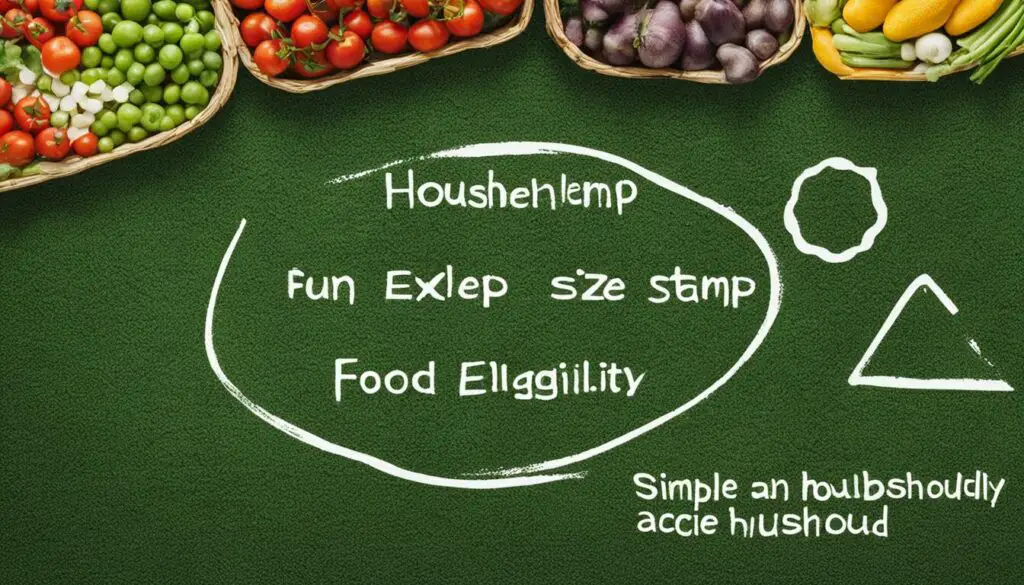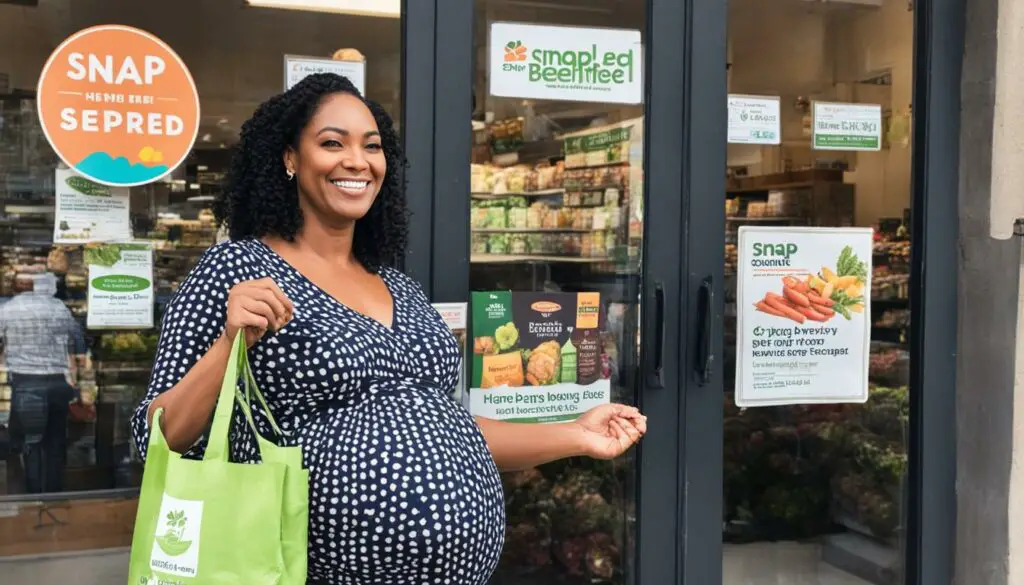Originally posted on December 20, 2023 @ 4:28 pm
Are you pregnant and wondering if you can get food stamps? Understanding the eligibility criteria for the Supplemental Nutrition Assistance Program (SNAP) is essential for accessing the support you may be entitled to. While being pregnant may not automatically qualify you for additional food stamps, there are other nutrition assistance programs available, such as the Women, Infants, and Children (WIC) benefits, specifically designed to assist pregnant women, new parents, and children up to 5 years old.
Table of Contents
Key Takeaways:
- Qualifying for food stamps while pregnant depends on factors such as household size, income, and assets.
- Household size includes any person you live with and buy or make food with, excluding adult children who buy or make their own food.
- Income requirements for food stamps consider both earned and unearned income, such as cash assistance or child support.
- Asset limits for food stamps typically include money in the bank, excluding retirement savings and recent tax returns.
- Other factors, such as being unemployed, having a drug felony conviction, non-citizenship, or homelessness, do not automatically disqualify you from applying for food stamps.
Household Size and Eligibility

The size of your household plays a crucial role in determining your eligibility for food stamps. To understand how household size affects your eligibility, it’s important to know who counts as a member of your household.
According to the food stamp program guidelines, any person you live with and buy or make food with is considered a member of your household. This includes:
- Children under the age of 22
- Individuals over the age of 60 or with disabilities, if you buy or make food together
However, it’s important to note that adult children who buy or make their own food may not be counted as household members. This means that their income and resources may not be taken into account when determining your eligibility for food stamps.
To help you better understand how household size affects eligibility, let’s take a look at the following example:
Anna is a single mother with two young children. They all live together and share meals. In this case, Anna and her two children would be considered a household of three eligible for food stamps.
It’s crucial to accurately determine your household size when applying for food stamps, as it directly impacts your eligibility and the amount of assistance you may receive.
Household Size and Eligibility Examples
| Household Size | Eligibility for Food Stamps |
|---|---|
| 1 adult | Eligible |
| 2 adults with no children | Eligible |
| Adults with adult children who buy/make their own food | Eligibility varies – adult children may not be counted as household members |
| Adult with children under 22 | Eligible |
| Elderly or disabled individuals living together and buying/making food together | Eligible |
Understanding how household size affects your eligibility is an important step in applying for food stamps. By accurately determining your household size and the members who count for eligibility, you can navigate the application process with confidence.
Income Requirements for Food Stamps
Your household income plays a crucial role in determining your eligibility for food stamps. It includes both earned income, which refers to money earned from jobs, and unearned income, such as cash assistance, Social Security, unemployment insurance, and child support.
It’s important to note that the specific income limit for food stamps varies by state and can change periodically. To determine your eligibility based on income, the best course of action is to start the application process.
When applying for food stamps, you will be required to provide information about your household income. This includes details of all sources of earned and unearned income within your household. By accurately reporting your income, you can ensure that your eligibility for food stamps is determined correctly.
Income Limit Examples by State
| State | Maximum Gross Monthly Income (for a household of four) |
|---|---|
| New York | $3,910 |
| California | $2,790 |
| Texas | $2,755 |
| Florida | $2,790 |
These figures are provided as examples and are subject to change. It’s important to check the income limit specific to your state by visiting the official website of your state’s Supplemental Nutrition Assistance Program (SNAP).
By evaluating the income requirements for food stamps and ensuring accurate reporting, you can determine your eligibility for this essential assistance program.
Asset Limits for Food Stamps

In addition to income, the value of your assets is also considered when determining your eligibility for food stamps. Assets typically include the amount of money you have in the bank, excluding retirement savings and recent tax returns. Some states may also consider real estate, investments, trusts, and vehicles as assets.
It is important to note that each state has different asset limits for food stamps. Let’s take a look at the asset limits for food stamps in Louisiana as an example:
| Household Composition | Asset Limit |
|---|---|
| Household without an elderly or disabled person | $2,250 |
| Household with at least one elderly or disabled person | $3,250 |
As you can see, the asset limit for food stamps in Louisiana is $2,250 for households without an elderly or disabled person, and $3,250 for households with at least one elderly or disabled person.
It is essential to check the specific asset limits in your state to determine your eligibility for food stamps based on your assets.
Other Factors Affecting Eligibility
While certain eligibility criteria must be met to qualify for food stamps, there are additional factors that can also impact your eligibility. It’s important to understand these factors to determine your eligibility for the Supplemental Nutrition Assistance Program (SNAP). Let’s explore some of these factors:
Unemployment and Food Stamps
Being unemployed does not automatically disqualify you from receiving food stamps. However, intentionally leaving a job or reducing work hours in order to qualify for benefits is not allowed. The eligibility for food stamps takes into consideration various aspects such as income, household size, and assets.
Drug Felony Conviction and Food Stamps
Individuals with a drug felony conviction may still be eligible for food stamps. The legislation surrounding this issue varies by state. Some states enforce temporary disqualifications, while others allow individuals with drug felony convictions to receive benefits without any restrictions.
Non-Citizens and Food Stamps
Non-citizens with qualified alien immigration status, such as refugees and victims of trafficking, can qualify for food stamps. It’s important to note that eligibility criteria may differ for non-citizens compared to U.S. citizens. However, non-citizens must meet the income and resource requirements set by the SNAP program.
Homelessness and Food Stamps
Homelessness does not prevent individuals from applying for food stamps. Those experiencing homelessness can still be eligible for SNAP benefits. The program aims to provide assistance to those in need, regardless of their housing situation.
Understanding these factors can help you navigate the eligibility criteria for food stamps and determine if you qualify for assistance. While the main factors include income, household size, and assets, it’s important to consider these additional factors to fully understand your eligibility for the SNAP program.
Applying for Food Stamps

If you’re in need of financial assistance to meet your food needs, applying for food stamps, also known as the Supplemental Nutrition Assistance Program (SNAP), can provide you with the help you need. The process for applying for food stamps may vary depending on the state you reside in, but there are a few common steps you can take to get started.
- Contact your local SNAP office: Reach out to your local SNAP office to learn more about the application process. They can provide you with the necessary information and guidance on how to proceed.
- Visit the state agency’s website: Many states offer online application portals on their official websites. These portals allow you to apply for food stamps conveniently from the comfort of your home.
- Call the SNAP Information hotline: If you prefer to speak with someone directly, you can call the SNAP Information hotline to get detailed instructions on how to apply and any documentation required.
Most applications can be completed online, but some states may offer options for in-person or telephone interviews as well. Ensure that you provide accurate information during the application process, as any discrepancies may delay the approval of your benefits.
Remember: It’s essential to complete the eligibility interview during the application process. This interview helps determine your eligibility for food stamps and allows you to answer any questions regarding your financial situation.
For a detailed breakdown of the application process in your state, visit the official website of your local SNAP office or contact them directly. They will be able to guide you through the specific steps needed to apply for food stamps and assist you in understanding the eligibility requirements.
Required Documentation for Food Stamp Applications
| Documents | Description |
|---|---|
| Proof of identity | Valid ID, driver’s license, or passport |
| Proof of residency | Utility bills, rental agreement, or mortgage statement |
| Proof of income | Pay stubs, tax returns, or letter from employer |
| Proof of household expenses | Utility bills, rent receipts, or medical expenses |
Snap Benefits for Pregnant Women

While you may not receive additional food stamps specifically because you’re pregnant, there are other programs that can provide support for pregnant individuals.
The Women, Infants, and Children (WIC) program is designed to assist pregnant women, new parents, and children up to 5 years old. WIC offers food and resources to ensure proper nutrition during pregnancy and early childhood.
Proper nutrition is vital for the health and well-being of both the pregnant woman and her developing baby. WIC provides access to nutritious foods, such as fruits, vegetables, whole grains, and protein-rich foods like eggs and beans. Additionally, WIC offers nutrition education, breastfeeding support, and referrals to other essential healthcare and community services.
It’s important to note that WIC and SNAP (food stamps) are separate programs, each with its own eligibility requirements and benefits. While you may not be eligible for SNAP benefits solely based on pregnancy, WIC can be a valuable resource to ensure you and your baby receive the nutrition you need during this critical time.
To learn more about the WIC program and see if you qualify, you can visit the official website or contact your local WIC office. Taking advantage of programs like WIC can provide additional support and resources to ensure a healthy pregnancy and a strong start for your child.
Other Nutrition Assistance Programs

Besides food stamps and the Women, Infants, and Children (WIC) program, there are other government assistance programs available to pregnant individuals. These programs aim to provide comprehensive support, including access to nutritious food, healthcare services, and financial assistance.
One such program is Medicaid, which offers low-income individuals and families access to healthcare services, including prenatal care, doctor’s visits, and hospitalizations. Medicaid is a state and federally funded program, and eligibility varies by state. Pregnant women may qualify for Medicaid even if they would not otherwise be eligible based on income.
Another program to consider is the Temporary Assistance for Needy Families (TANF) program, which provides financial assistance to low-income families. TANF benefits can help cover basic needs, including food, shelter, and clothing. Eligibility for TANF is determined by each state, and pregnant women may be eligible for additional support.
In addition, the Special Supplemental Nutrition Program for Women, Infants, and Children (WIC) offers nutrition assistance for pregnant women and new mothers. WIC provides eligible individuals with vouchers that can be used to purchase nutritious foods, such as fruits, vegetables, whole grains, and dairy products. WIC also offers nutrition education and support services to promote healthy pregnancies and early childhood development.
Exploring all available nutrition assistance programs is essential to ensure you receive the comprehensive support you need during your pregnancy. These government programs are designed to assist pregnant individuals and provide access to proper nutrition, healthcare, and financial resources.
| Program | Description |
|---|---|
| Medicaid | State and federally funded program providing healthcare services to low-income individuals, including prenatal care and hospitalizations. |
| Temporary Assistance for Needy Families (TANF) | Financial assistance program that provides support to low-income families for basic needs, including food, shelter, and clothing. |
| Special Supplemental Nutrition Program for Women, Infants, and Children (WIC) | Nutrition assistance program offering vouchers for healthy foods and nutrition education to eligible pregnant women and new mothers. |
Benefits Finder Tool
If you’re unsure about the benefits you might be eligible for, there is a helpful online tool called the Benefits Finder. This tool can assist you in finding your eligibility for various government assistance programs, including those relevant to your pregnancy.
By inputting your personal circumstances into the Benefits Finder, such as your income, household size, and pregnancy status, you can receive customized information about the programs you may qualify for. The Benefits Finder takes into account specific eligibility criteria and provides you with a detailed list of applicable programs and their available benefits.
| Benefits | Description |
|---|---|
| Supplemental Nutrition Assistance Program (SNAP) | Assistance with purchasing food for you and your family. |
| Women, Infants, and Children (WIC) | Nutrition assistance for pregnant women, new parents, and children up to 5 years old, offering food and resources to ensure proper nutrition during pregnancy and early childhood. |
| Temporary Assistance for Needy Families (TANF) | Financial assistance for low-income families, including cash benefits and support services. |
| Medicaid | Healthcare coverage for individuals and families with low incomes. |
Using the Benefits Finder tool can simplify the process of finding the right government assistance programs for your needs. It saves you time and effort by providing accurate information based on your unique situation. Remember to always explore your eligibility for all available programs to ensure you receive the support you require during your pregnancy.
Recertifying for SNAP Benefits
Once you have been determined eligible for SNAP benefits, it is important to note that the benefits are not indefinite. You will receive a notice that outlines the length of your certification period, which is the duration for which you are eligible to receive SNAP benefits.
Before your certification period comes to an end, you will need to go through a recertification process to continue receiving benefits. Recertification helps ensure that you still meet the eligibility criteria and need continued assistance.
Your local SNAP office will provide you with the necessary information and instructions on how to recertify. It is crucial to follow the instructions provided and complete the recertification process on time to avoid any interruption in your benefits.
During the recertification process, you may be required to provide updated information about your household size, income, assets, and any changes in circumstances that may affect your eligibility for SNAP benefits. It is essential to provide accurate and current information to ensure that your benefits are correctly determined.
Recertification for SNAP benefits is an opportunity for you to confirm your ongoing eligibility and continue receiving the support you need to meet your nutritional needs. Be sure to stay in contact with your local SNAP office and follow their guidance throughout the recertification process.
Importance of Timely Recertification
Timely recertification is critical to avoid a disruption in your SNAP benefits. Failing to recertify on time may result in a temporary loss of benefits until your eligibility is reestablished. It is essential to understand the recertification timeline and submit the required documentation within the specified timeframe.
“Recertification ensures that you still meet the eligibility criteria and need continued assistance. Stay in contact with your local SNAP office and follow their guidance throughout the recertification process.”
SNAP Recertification Timeline
| Month | Certification Period End Date | Recertification Deadline |
|---|---|---|
| January | June 30th | May 15th |
| February | July 31st | June 15th |
| March | August 31st | July 15th |
| April | September 30th | August 15th |
| May | October 31st | September 15th |
| June | November 30th | October 15th |
| July | December 31st | November 15th |
| August | January 31st | December 15th |
| September | February 28th (or 29th on leap years) | January 15th |
| October | March 31st | February 15th |
| November | April 30th | March 15th |
| December | May 31st | April 15th |
It is important to note that the recertification timeline and deadlines may vary depending on your state and individual circumstances. Be sure to consult with your local SNAP office for the specific requirements that apply to you.
Recertifying for SNAP benefits is a necessary step to continue receiving the support you need. Ensure that you stay informed about the recertification process and meet all the requirements to avoid any interruption in your benefits.
Conclusion
Understanding the eligibility criteria for food stamps while pregnant is crucial for accessing nutrition assistance programs. While the SNAP program may not provide additional benefits specifically for pregnancy, programs like WIC offer comprehensive support for pregnant individuals. By exploring all available resources and applying for the appropriate programs, you can ensure that you receive the necessary financial support and access to nutritious food during your pregnancy.
FAQ
Can you get food stamps while pregnant?
While pregnant, you may not be eligible for additional food stamps. However, there are other nutrition assistance programs available.
What is considered the household size for determining food stamp eligibility?
The household size includes any person you live with and buy or make food with. This can include children under the age of 22 and individuals over 60 or with disabilities, if you buy or make food together. Adult children who buy or make their own food may not be counted as household members.
How does income affect eligibility for food stamps?
Income, including earned income from jobs and unearned income such as cash assistance or Social Security, is a crucial factor in determining eligibility. The specific income limit varies by state and can change periodically.
What assets are considered when determining food stamp eligibility?
Assets typically include money in the bank (excluding retirement savings and recent tax returns). Some states may also consider real estate, investments, trusts, and vehicles. The asset limit for food stamps varies by state.
What other factors can affect eligibility for food stamps?
Being unemployed does not automatically disqualify you, but intentionally reducing hours or leaving a job to qualify is not allowed. Individuals with a drug felony conviction can still be eligible. Non-citizens with qualified alien immigration status may also qualify, and homelessness does not prevent you from applying for food stamps.
How do I apply for food stamps?
The application process varies by state. You can usually contact your local SNAP office, visit the state agency’s website, or call the SNAP Information hotline. Most applications can be completed online, but there may be options for in-person or telephone interviews as well.
Can I receive SNAP benefits while pregnant?
You may not receive additional food stamps specifically because you’re pregnant. However, other programs like the Women, Infants, and Children (WIC) program provide support to pregnant individuals.
Are there other nutrition assistance programs available for pregnant women?
Yes, besides food stamps and WIC, there may be other government assistance programs that provide comprehensive support, including access to nutritious food, healthcare services, and financial assistance.
Is there a tool to help determine eligibility for benefits?
Yes, there are online tools like the Benefits Finder tool that can help you determine your eligibility for various government assistance programs based on your personal circumstances, including pregnancy.
How long can I receive SNAP benefits?
If you are found eligible for SNAP benefits, you will receive a notice outlining the length of your certification period. Before this ends, you will need to go through a recertification process to continue receiving benefits.
Source Links
- https://www.joinproviders.com/state/louisiana/food-stamps-eligibility-income-limits/
- http://parenthelp123.org/pregnancy/food-assistance-preg/
- https://www.fns.usda.gov/snap/recipient/eligibility
See also:
Leave a Reply